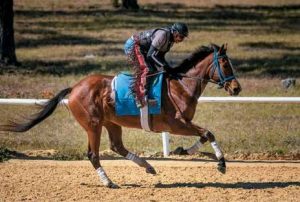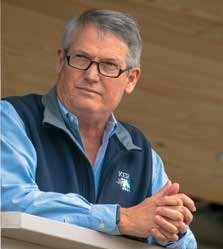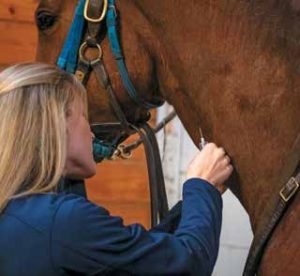By “Amanda Duckworth“
ANY ATHLETE WILL tell you that nutrition is an important part of the equation when it comes to performance—and that is no different when it comes to racehorses. The science behind what works best has been well studied in recent decades, but understanding it, applying it, and getting the horses themselves to buy into it are not always straightforward.
It should come as no surprise that racehorses need to consume more calories than their pleasure horse compatriots. Getting the balance right among all the nutrients they consume is a baseline necessity
“There is an exponential amplification of calorie intake, as well as all nutrients that are required for basic metabolic maintenance plus energy production in horses working at maximal exertional effort,” said equine nutritionist Dr. Amy Gill, founder of Equi-Force. “In order for these horses to be able to work at a very intense level of exercise, all nutrients, cofactors, and enzymes that are required for the biochemical processes of exercise and training, like muscular contraction and aerobic and anaerobic respiration, need to stay in balance. When one nutrient is increased, all others must increase not only in amount but in proper relation to each other.”
In the last several decades, horse people have sought to achieve this balance by buying pre-mixed feed instead of mixing their own. Science and practicality have combined in favor of feed companies.
“There is certainly a lot less hand mixing now,” said Anthony Koch, the director of sales and marketing for Hallway Feeds. “One reason is that the science has developed and gotten us to the point where we can put it in the feedbag for the horsemen and it is balanced. If you go to mixing on your own, you can actually disturb the balance that is in place for your horse.
“I also think one of the reasons trainers have moved toward accepting they can feed straight out of the bag sometimes has to do with labor, too. It has made it easier on the people in the shedrow to be able to feed the horses and know they can rely on it. If they have to mix six different ingredients to make a meal for each horse, it might not happen correctly every time.”
The balance of nutrients is so crucial because of the way feed affects the horse. In addition to making sure a horse maintains the right weight through calories, it also is significant for its bone structure.
“In the past, oats were sort of the staple grain for horses, so most rations were based on an oat diet,” said Dr. Joe Pagan, founder of Kentucky Equine Research. “Oats in and of themselves, while they have really good energy characteristics of their fat content, starch content, and even fiber content, they have a lousy mineral profile. If you don’t balance it, you can really have some problems.
“The big imbalance is that it has more phosphorous than calcium, so if you weren’t feeding the correct type of supplement with it, and you had an inverted calcium-phosphorus ratio, you could have some real skeletal issues, including lameness and fractures. That all kind of got cleaned up when these commercial feeds came into being, and we balanced it. People like the simplicity that you don’t have to mix and match on your own.”
In addition to using pre-mixed feed, the other big shift for racehorse nutri- tion has involved turning to a higher-fat diet. This concept is now fairly standard, although the optimum percentage of fat continues to be debated.
“We took some of the starch and sugar you were feeding in a straight oat diet and replaced it with fermentable fiber sourc- es and fat sources, with the fermentable fiber being primarily beet pulp and the fat sources being primarily vegetable oil,” said Pagan. “When we
did that 20 some odd years ago, we got the formula pret- ty right. The stuff we recommend now hasn’t changed that much for a normal, healthy racehorse. It is where we are put- ting 6-8% fat in the concentrate. For 90% of the horses, that is a good match.
“We made a big discovery about the same time that horses that had some specific muscle problems, namely recur- rent exertional rhabdomyolysis or RER, which is the common form of tying-up in Thoroughbreds, needed even less carbo- hydrates and even more fats. There are some companies now that have drifted a little bit into higher-fat diets, up to 10- 12%, and I am not talking about tying- up horses. I am talking about regular racehorses, and I think that may be a mistake. They have kind of overdone the dependence on fat as opposed to carbo- hydrates in normal, healthy racehorses.
I will say the most popular race feeds in America, one of which is Race 13 from Hallway, stay in that sweet spot of 6-8% for fat.”
BEYOND THE NORM
While the majority of race horses will do well on standard race feed, there are always going to be exceptions. Using sci- ence to figure out the best way to get the proper nutrition into a horse with issues has come into focus in recent years.
“I don’t think we are going to uncover a completely new type of feed—those are pretty time-tested for Thoroughbred racehorses now—but there are a lot of these other interesting things around it that are adjunctive support of that core feed,” said Pagan. “It has to do with trying to reduce inflammation, reduce oxida- tive stress, reduce gastric ulcerations— these things that are sort of side effects of having a horse in heavy training.
“When racehorses are just doing reg- ular maintenance gallops, the intensity of those training sessions is a lot higher than what almost any other horse does even during competition. You are going to have some of these issues when you have a horse at that level that you wouldn’t have anywhere else. So, our focus is on how can we prevent some of these things from happening.”
The idea that there are ways to im- prove the base feed for horses with recur- ring issues is a major motivator behind the work at Equi-Force as well.
“My company model is based on tar- geting specific nutrients that have been clinically studied and shown to exert a positive physiological effect when fed at therapeutic level,” said Gill. “Targeting nutrients to improve the overall health of the horse is the biggest change we have recognized in the last 10 years. We are giving the horse the raw materials to fix the problem instead of just relying on pharmaceuticals to treat symptoms. Our goal is to correct the disorder, not just put a band-aid on clinical symptoms.
“For inflammatory issues, we are using omega-3 fatty acids; for hindgut and colon issues we are using sodium butyr- ate; for bone and soft-tissue deficiencies we are using bioavailable silicon; and for metabolic issues we are using a combina- tion of ingredients that rebalance insulin and glucose metabolism. Those are four categories we are really focused on giving the horse nutritional therapy. These tar- geted nutrient therapies must be added to the regular ration—they are not natu- rally found in feed stuffs and/or are not in a high enough amount you need to get a therapeutic effect.”
“IF YOU ASK A TRAINER WHAT IS THE MOST IMPORTANT THING ABOUT A HORSE FEED… I BET 90%…MAYBE AS HIGH AS 99% WILL SAY ‘THAT THE HORSE WILL EAT IT AND STAY ON IT.’ ”
— DR. JOE PAGAN
FEEDING TIME
When it comes to internal issues, one of the most commonly occurring race- horse ailments is gastric ulcers. Proper feeding and management can have a pro-found impact on horses suffering from the issue, but stubbornness from both humans and horses can make it more complicated than expected.
THIS IS GOING TO SOUND FUNNY COMING FROM A FEED COMPANY, BUT YOU HAVE TO HAVE HIGH- QUALITY HAY AND A CLEAN SOURCE OF WATER.”
— ANTHONY KOCH
“A horse is meant to graze about 18-20 hours a day, and they generally eat 10-12 meals a day,” said Gill. “Unless they are eating this way, it becomes increasingly difficult for them to ingest and digest food correctly. That being said, we never recommend that a horse have an empty stomach, especially when going out to train or race. That’s how gastric ulcers are formed—when nothing is coating the upper mucosa, and the lining is vulner- able to acid.
“Therefore, all horses should always have a small amount of digesta in the stomach. They should be eating small meals frequently throughout the day. anyway, and there should be no changes on work or race days whatsoever. Rou- tine and consistent feeding are the best ways for a horse to be managed.”
Horsemen have a reputation for being traditional, but there has been a move in recent years to feed racehorses smaller meals more often as opposed to just one or two large meals a day.
“Feeding racehorses multiple times per day is important,” said Koch. “I have been making the rounds to racetracks for 18 years, and I think it is widely accepted now to feed at the very minimum three meals per day to performance horses. Whenever you have that conversation about getting more calories in a horse, or how to feed them more, or why some horses are scared of really large meals, the answer is always that we just need to feed them smaller meals more often.”
Additionally, a key to any horse’s nu- tritional well-being is constant access to quality hay, no matter what type of feed a horse is on.
“Forage or hay is the most important part of the diet as it supplies the most cal- ories and nutrients,” said Gill. “The horse should be eating the best-quality, softest, most immature hay it can possibly get, and it should be fed on the ground, not in a hay bag. Horses like to forage, and they should be allowed to move
the hay around in their stall to simulate grazing.”
Koch echoed Gill’s sentiments on the importance of hay, saying: “This is going to sound funny coming from a feed company, but you have to have high-quality hay and a clean source of water. You have to start there, and you can’t skimp on the hay. If those things aren’t good, we can’t make up for it with our best feeds.”
EATING IS THE HARDEST PART
For all the good intentions, much like that old adage about
WE NEVER RECOMMEND THAT A HORSE HAVE AN EMPTY STOMACH, ESPECIALLY WHEN GOING OUT TO TRAIN OR RACE. THAT’S HOW GASTRIC ULCERS ARE FORMED.”
— DR. AMY GILL
hay, but you cannot always make it eat. “We did a study with my racehorses
at the training center, and even though we had given them free choice, beautiful hay, they only ate about 1% of their body weight as hay,” said Pagan. “The rule of thumb is feed your horse 1.5%, but the horse also has actually to eat that 1.5%.
“The thought that if you just give them all the hay they can eat, then they will buffer their stomach on their own doesn’t always work, at least not in the study we did. If you have a horse who hasn’t been eating through the night, and it has that kind of acid in its stomach first thing in the morning, then you take it out for a gallop, all of that acid gets sloshed all
over the top of the stomach and burns it.” Being finicky also applies to feed. Racehorses especially can be prone to going off their grain, which can cause a chain reaction of issues when it comes to
both overall health and performance.
“If you ask a trainer what is the most important thing about a horse feed, I bet 90% and maybe even as high as 99% will say ‘that the horse will eat it and stay on it,’ said Pagan. “When you get a horse really tightened up, its going off its feed is a trainer’s worst nightmare. Keeping a feed palatable is really an important thing.”
When trying to figure out the best feed for a horse, especially one that is not an easy keeper, it helps to work with someone who has a sci- entific understanding of what racehorses need to thrive.
“Approach a qualified nu- tritionist about the best way to feed your horse, and if an equine nutritionist is not avail- able, go to a respectable feed company,” said Gill. “ They have trained personnel that can give correct advice on how to improve the feeding regime as a whole, not just the feed. Total management of the
horse, from psychological to physiological health, is just as important if not more than the water, you can lead a horse to Nutritional values can be measured by testing blood samples feed itself.” B






